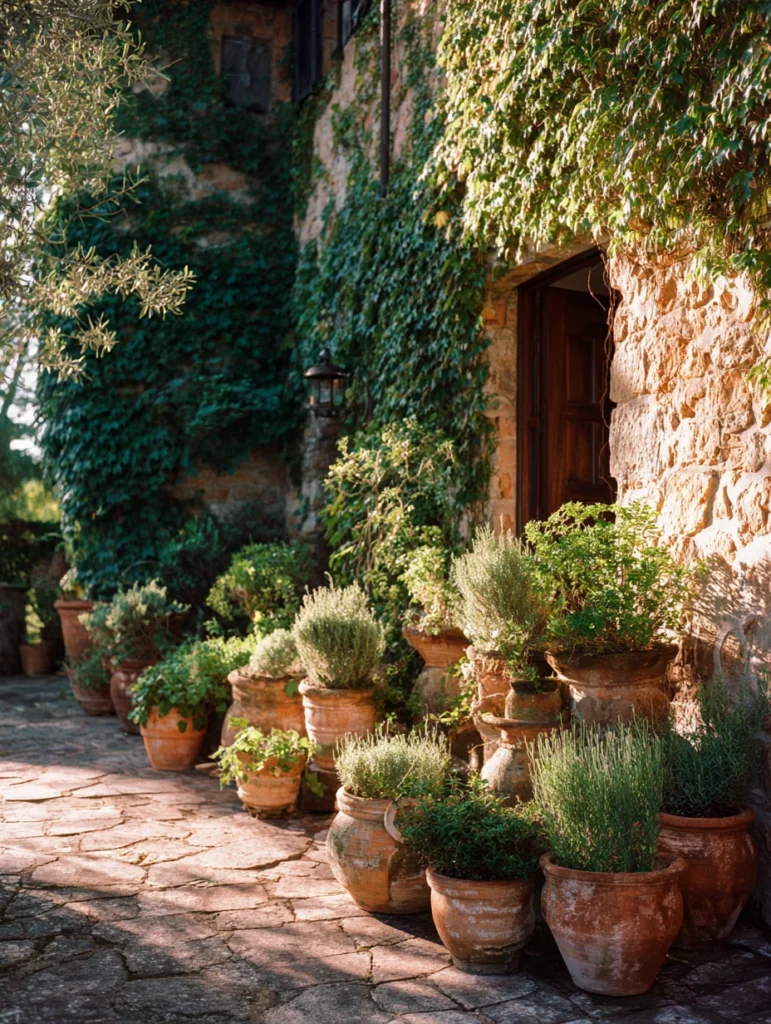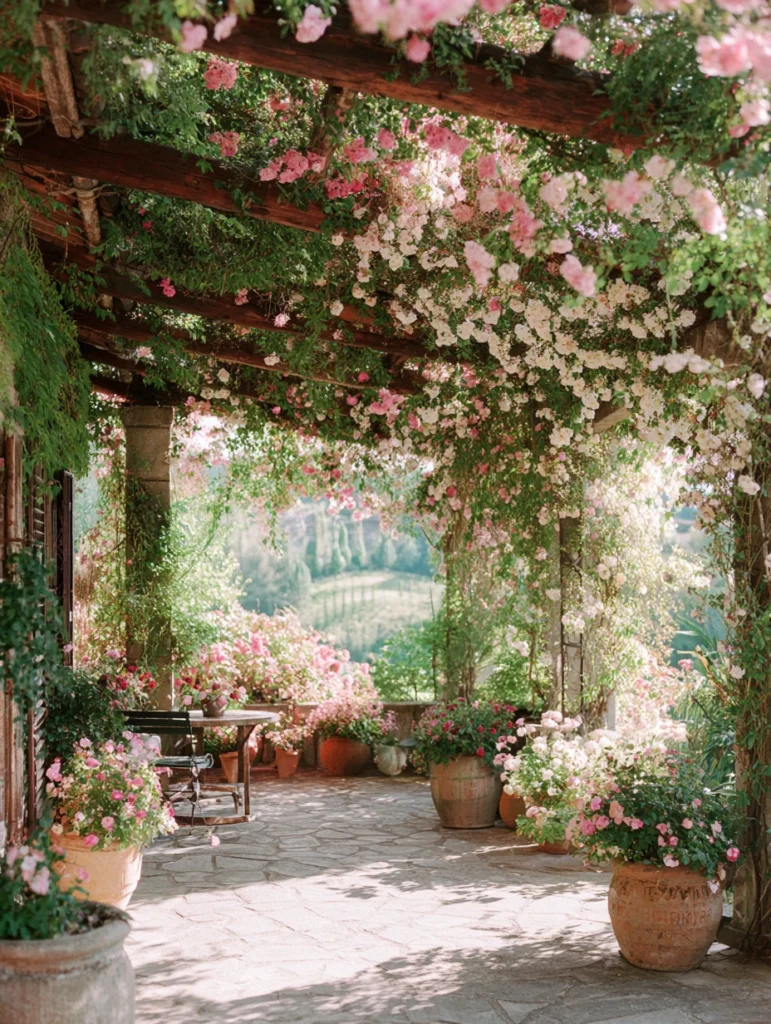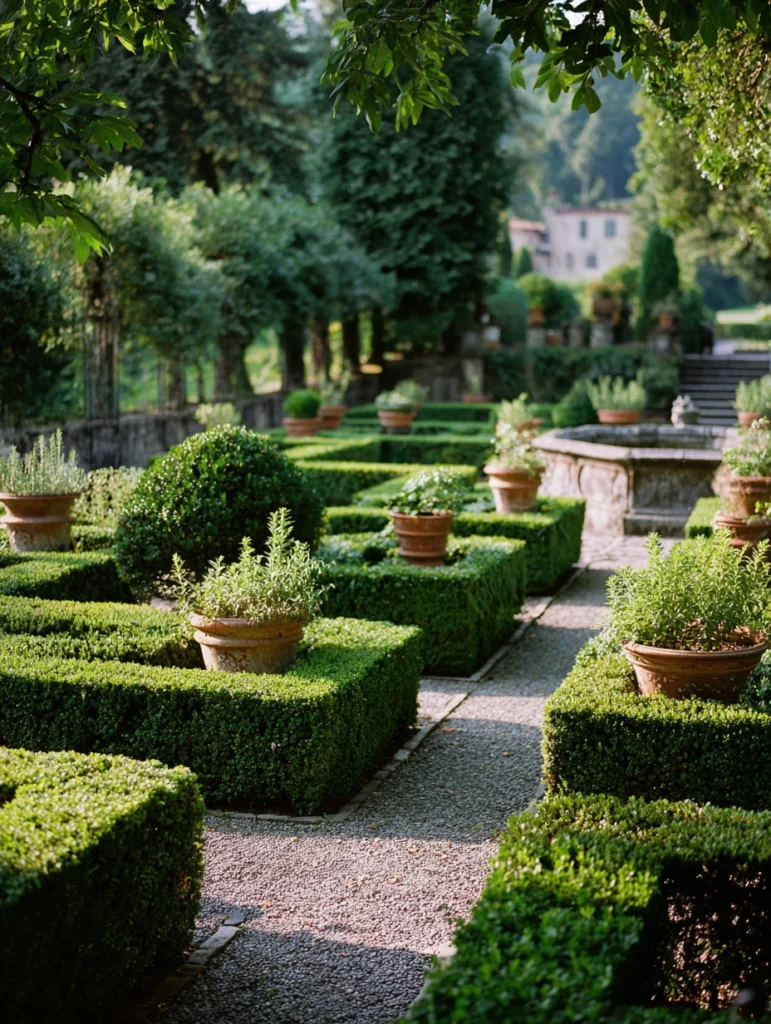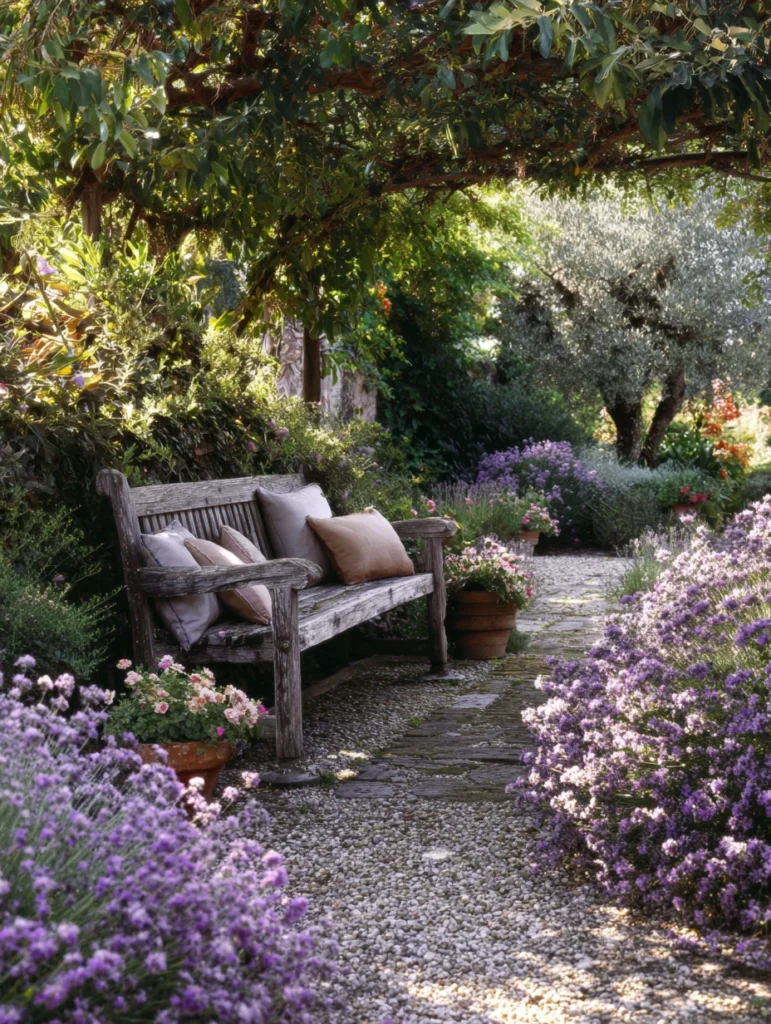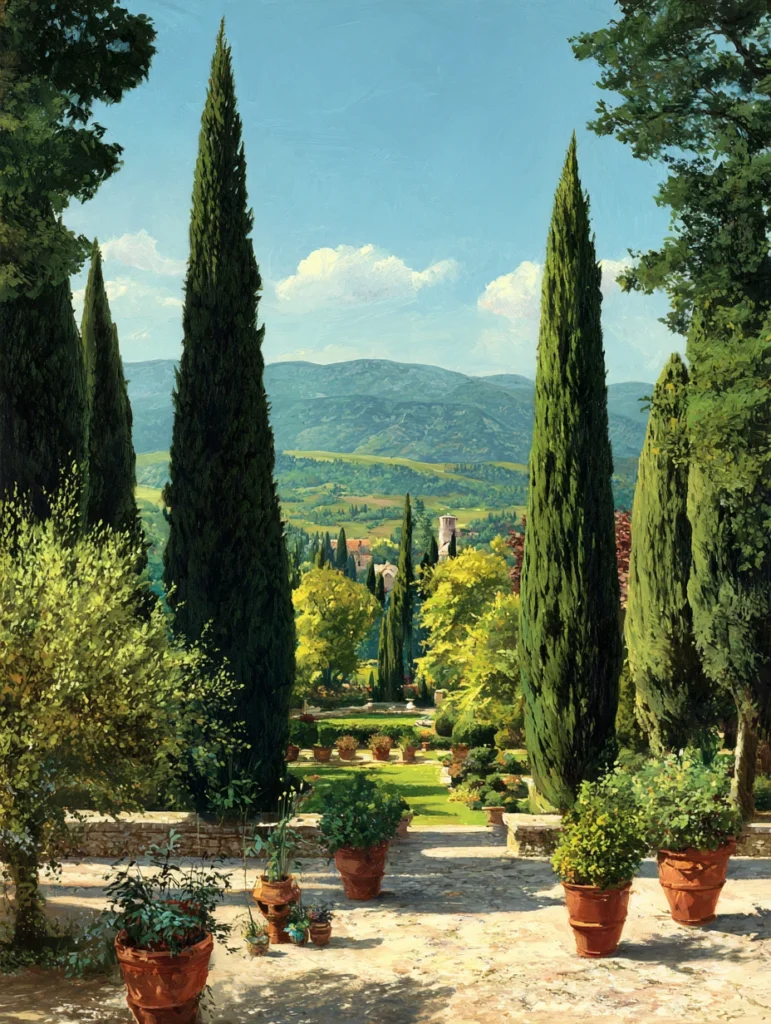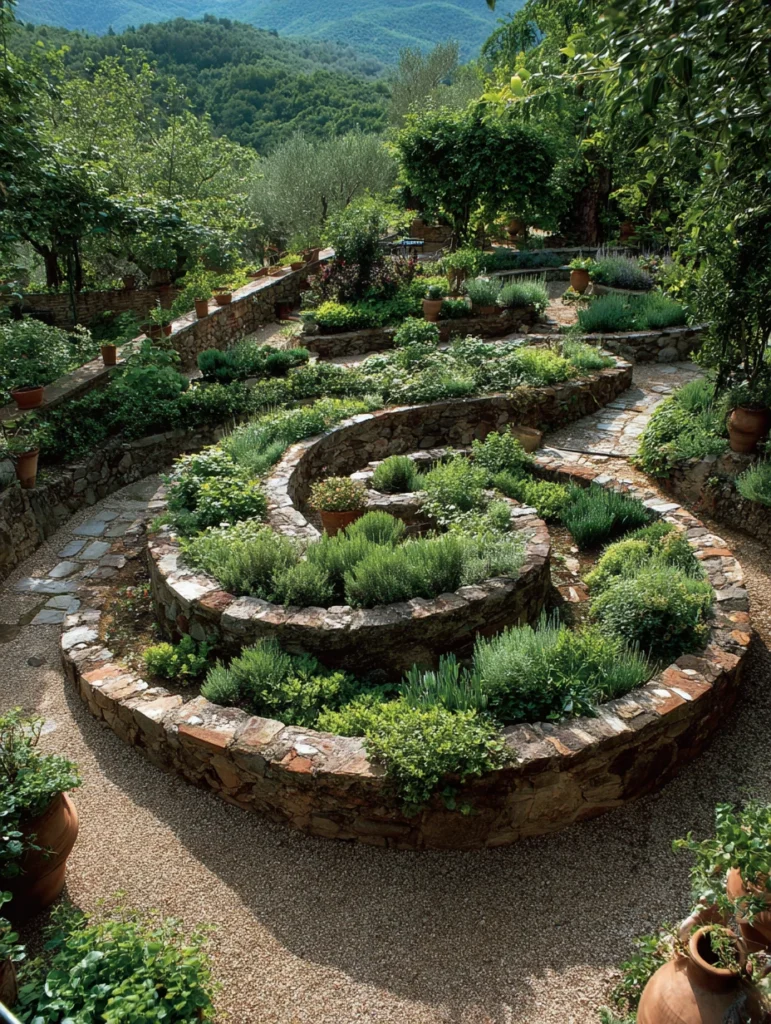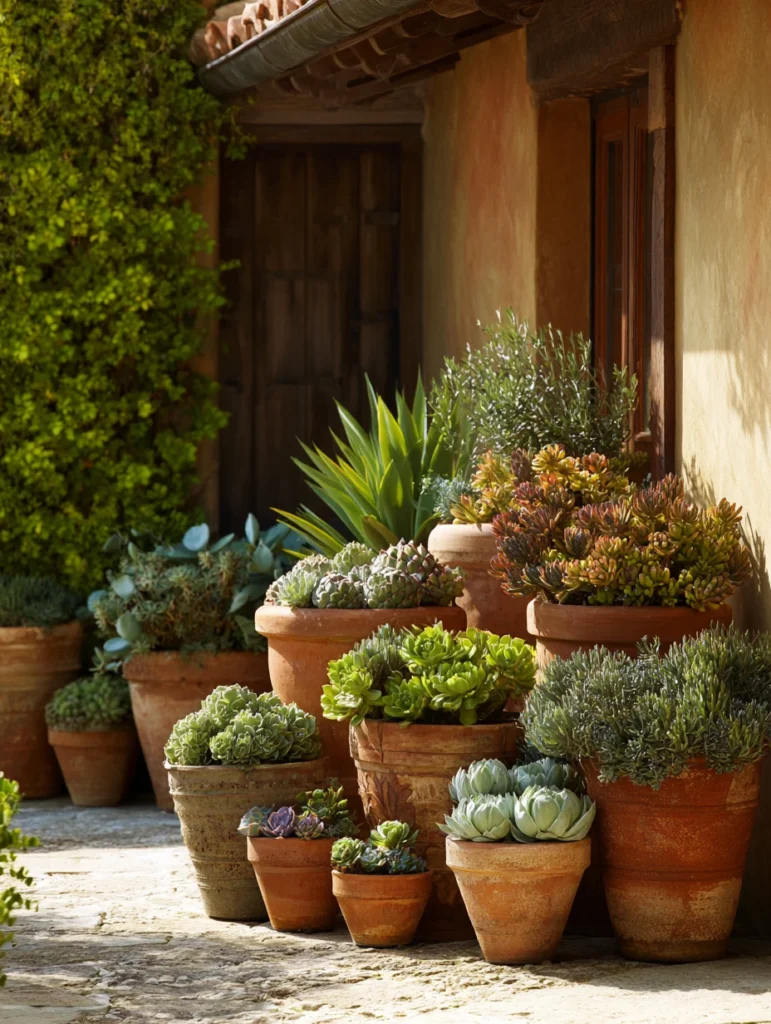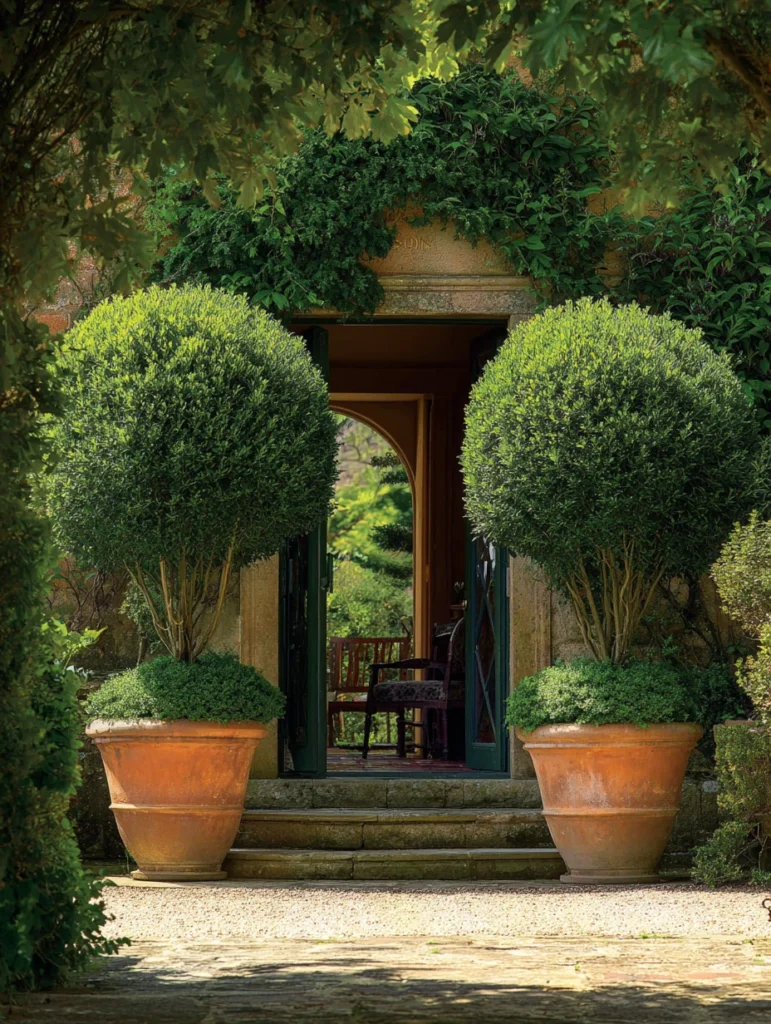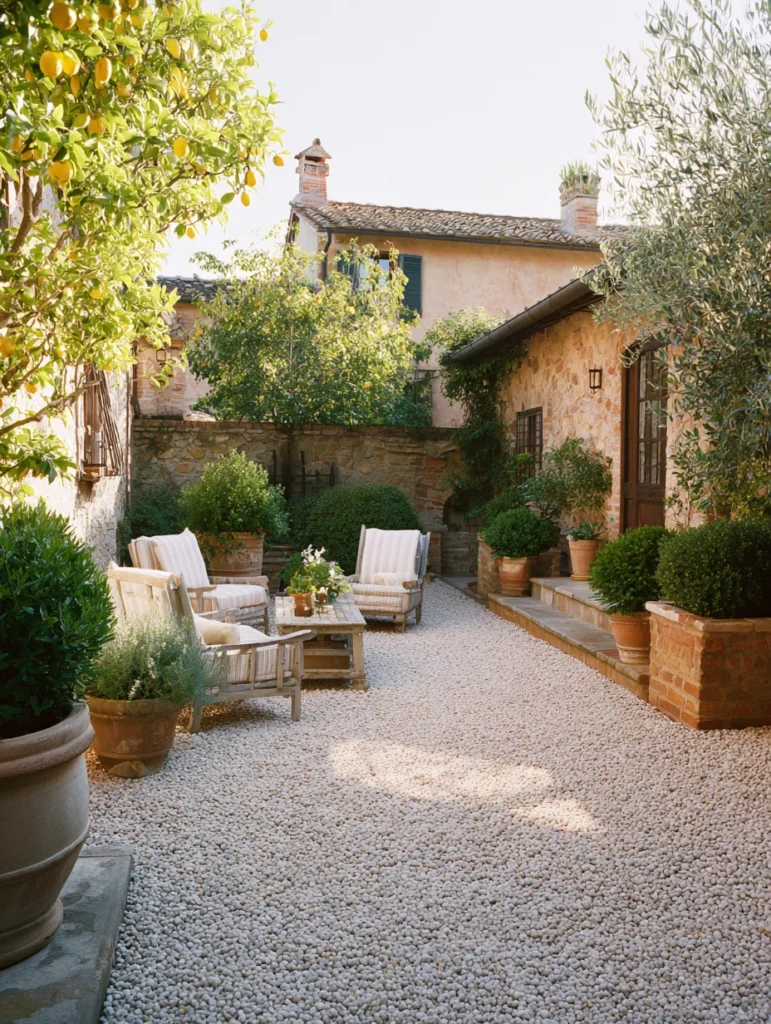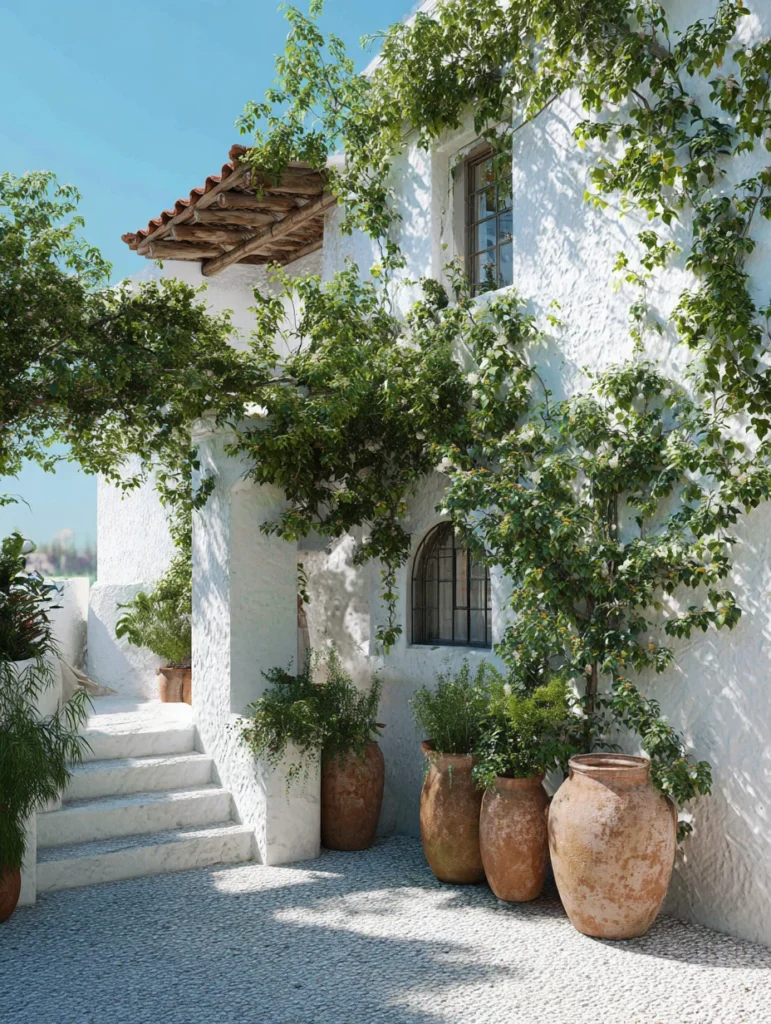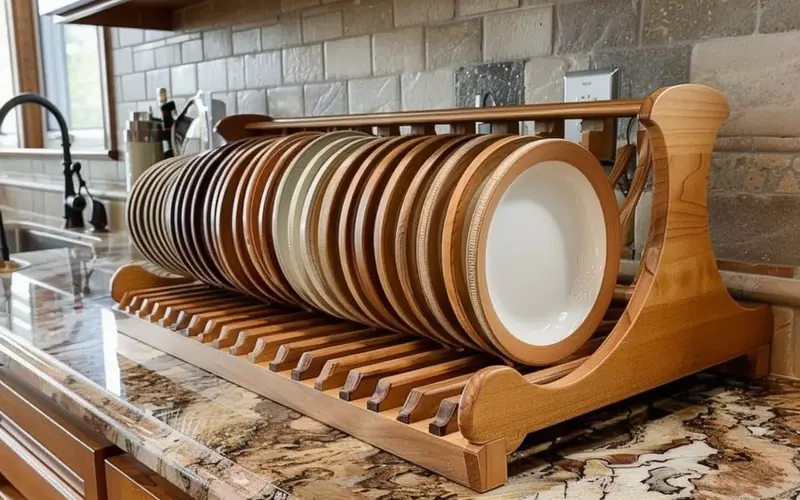You know that feeling when you’re scrolling through vacation photos and wish you could bottle up that Italian villa vibe? I get it. The good news is you don’t need a plane ticket to Tuscany to create that sun-soaked, romantic garden atmosphere right in your backyard.
Italian gardens blend old-world charm with practical beauty – think terracotta pots overflowing with herbs, gravel paths that crunch underfoot, and that perfect balance between structure and wildness. Ready to transform your outdoor space into a little slice of Italy?
1. Classic Terracotta Pot Arrangements
Start with the Essentials: Terracotta pots are the backbone of any Italian garden, instantly enhancing the overall look of the space. Group them in odd numbers and vary the heights for visual interest. Fill them with Mediterranean herbs like rosemary, basil, and oregano. The earthy orange color complements every plant you put in them, and they develop this gorgeous patina over time.
Create Visual Interest: Don’t line them up like soldiers – stack smaller pots on overturned larger ones and let some trail their contents over the edges. Mix sizes aggressively for depth. A giant statement pot near your entrance, paired with medium and small ones scattered throughout, creates that curated Italian courtyard feel.
Product Spotlight: The Sunnydaze Decor Italian Terracotta Planter Set offers a range of sizes, allowing you to experiment with arrangements right away. Pair it with the Classic Home and Garden Rolled Rim Planter for authentic Mediterranean looks – the hand-finished details make each pot unique.
Read More: 21 Inspiring Vegetable Garden Design Ideas
2. Gravel Pathways With Character
Ditch the Concrete: Gravel Paths are Quintessentially Italian and Easier to Install Than You Think. Choose warm-toned pea gravel or crushed stone – nothing too uniform. The crunching sound adds a satisfying sensory element, and they drain incredibly well after rainstorms.
Edge It Right: You need edging to contain that gravel, or it’ll end up everywhere. Use natural stone, reclaimed brick, or metal edging to create clean lines that contrast with the loose, organic gravel. The border makes all the difference between polished and messy.
Product Spotlight: The Vigoro Decorative Landscape Edging keeps your gravel exactly where it belongs without looking industrial. Add the Exotic Pebbles & Aggregates Crushed White Marble Chips for that authentic Italian courtyard feel – the white marble catches sunlight beautifully.
Read More: 21 Small Zen Garden Ideas for a Tranquil Home
3. Climbing Roses on Pergolas
Romance Overhead: Nothing says Italian garden like roses climbing a weathered pergola. Choose fragrant varieties in soft pinks, creamy whites, or deep reds. Train them to weave through the structure as they grow, creating that effortless, romantic canopy that provides dappled shade.
Pick the Right Structure: Your pergola doesn’t need to be massive or expensive. A simple cedar or treated wood structure works beautifully. Position it over a seating area or pathway where you’ll actually enjoy the blooms and fragrance up close.
Product Spotlight: The David Austin Climbing Rose Collection offers those old-world blooms with incredible fragrance that Italian gardens are known for. Support them with the Gardener’s Blue Ribbon Bamboo Stakes while they establish – natural materials always look better than plastic in this setting.
Read More: 21 Cottage Garden Ideas for a Whimsical Space
4. Boxwood Hedges for Structure
Define Your Spaces: Boxwood hedges bring that formal Italian structure without feeling stuffy. Use them to edge pathways, frame garden beds, or create outdoor rooms. They stay green year-round and require minimal maintenance once established. The clean lines contrast beautifully with wilder, flowering plants.
Keep It Simple: Don’t overthink the shapes – simple, rounded, or squared hedges work best. Trim them twice a year to maintain their form. Plant them closer together than you think for that thick, lush look Italians master so well.
Product Spotlight: American Boxwood Live Plants establish quickly and tolerate a wide range of conditions. Pair with the Fiskars PowerGear2 Hedge Shears to keep those clean lines sharp – the gear mechanism makes trimming effortless even on thick branches.
Read More: How to Design a Container Garden for Your Flowers
5. Lemon Trees in Oversized Containers
Bring the Citrus: Lemon trees scream Italian countryside, and growing them in containers means you can move them indoors during winter if needed. Position them near your entrance or on a sunny patio where their glossy leaves and bright fruit become instant focal points.
Pick Your Spot Wisely: These trees love sun – at least six hours daily. The fragrance from their blooms is intoxicating, so place them where you’ll walk past regularly. Water consistently, but avoid overdoing it; citrus plants dislike wet feet.
Product Spotlight: The Improved Meyer Lemon Tree produces fruit reliably and tolerates container life better than other varieties. Plant it in the Bloem Ariana Planter with Grid – the self-watering reservoir keeps your tree happy during hot summers.
Read More: Amazing Herb Garden Ideas for Your Outdoor Oasis
6. Stone Wall Water Features
Add Movement and Sound: Water features are central to Italian gardens, and a stone wall fountain creates a soothing trickle without occupying floor space. The sound masks street noise and attracts birds. Choose something with aged stone or weathered copper for authenticity.
Installation Made Easy: Wall fountains are surprisingly simple to install – most just need a nearby outlet and a sturdy wall mount. Position it where you’ll hear the water from your favorite seating spot. The visual and auditory elements work together to create that tranquil atmosphere.
Product Spotlight: The Sunnydaze Mediterranean Lion Wall Fountain brings classic Italian styling with easy installation. Power it with the Smart Solar Solar-on-Demand Fountain Pump for eco-friendly operation that won’t spike your electric bill.
Read More: 21 Corner Garden Ideas to Transform Your Backyard
7. Lavender Borders Everywhere
Purple Perfection: Lavender borders are non-negotiable in Italian gardens. The silvery foliage and purple blooms complement each other perfectly, and the fragrance is pure magic. Plant them along pathways, around seating areas, or anywhere you want to create a Provence-meets-Tuscany vibe.
Choose the Right Variety: English lavender is more tolerant of humidity than French varieties. Space them about 12 inches apart – they’ll fill in quickly. Cut them back after blooming to keep them compact and encourage more flowers.
Product Spotlight: The Phenomenal Lavender Live Plants tolerate both heat and humidity better than traditional varieties. Feed them with Jobe’s Organics Herb Fertilizer Spikes for steady growth and abundant blooms throughout summer.
Read More: Stunning Flower Bed Ideas for the Front of the House
8. Rustic Wooden Benches
Create Gathering Spots: A weathered wooden bench tucked into a quiet corner invites you actually to use your garden. Skip the pristine, painted options – you want something that looks like it’s been there forever. Position it where you’ll catch morning sun or evening shade.
Let It Age Naturally: Don’t fight the weathering process. That silvery-gray patina that develops is exactly what you want. Add cushions in terracotta, olive green, or faded blue for comfort and color.
Product Spotlight: The Leigh Country Acacia Hardwood Outdoor Bench develops that perfect aged look naturally over time. Top it with the Mozaic Company Sunbrella Indoor/Outdoor Cushion in a muted tone that won’t compete with your plants.
Read More: 17 Garden Ideas for Small Spaces and Maximum Yield
9. Cypress Trees as Sentinels
Vertical Drama: Italian cypress trees create that iconic vertical accent that draws the eye skyward. Plant them as singles for drama or in pairs to frame an entrance. They’re surprisingly low-maintenance and stay narrow, making them ideal for even smaller spaces.
Strategic Placement: Use them to mark transitions between garden areas or create privacy screens without blocking light. Their dark green color provides year-round structure and contrasts beautifully with flowering plants.
Product Spotlight: The Italian Cypress Tree ships well-established and grows fast. Protect young trees with the Dalen Gardeneer Tree Protector until they’re sturdy enough to handle wind on their own.
Read More: How To Create a Beautiful Rose Garden To Inspire You
10. Olive Jars as Statement Pieces
Instant Italian Character: Large olive jars (or replicas) add instant authenticity to your space. Use them as standalone sculptures, fill them with trailing plants, or group them with smaller pots for a cohesive look—the aged terracotta and classic amphora shape transport you straight to Tuscany.
Style Them Right: Don’t overcomplicate it – sometimes an empty jar positioned at a pathway intersection or garden corner is perfect. If you fill them, choose cascading plants like trailing rosemary or creeping thyme that soften the structured shape.
Product Spotlight: The Sunnydaze Athena Urn Planter captures that classic olive jar silhouette with drainage holes for planting. The Tuscan Path Rustic Mediterranean Oil Jar works beautifully as a standalone statement piece without planting.
Read More: 21 Japanese Garden Ideas for Serene Outdoor Spaces
11. Wisteria-Covered Arbors
Create a Living Tunnel: Wisteria transforms simple arbors into breathtaking features when those purple cascades bloom in spring. The twisted vines and hanging flowers are pure Italian romance. Position your arbor where you’ll walk through it regularly to enjoy the fragrance.
Plan for Growth: Wisteria grows aggressively – that’s not a complaint, just reality. Choose a sturdy structure that can handle the weight, and be prepared to prune it back regularly. The effort pays off when those blooms appear.
Product Spotlight: The Dura-Trel Cambridge Arbor provides the intense support wisteria demands while looking elegant in your garden. Start your wisteria with the Blue Moon Wisteria Vine – it blooms reliably and handles various climates.
Read More: 21 Stunning Mediterranean Garden Ideas To Inspire You
12. Herb Spiral Gardens
Function Meets Beauty: Herb spirals maximize growing space while creating visual interest. Build a spiral raised bed using stone or brick, and plant Mediterranean herbs at varying heights to create a visually appealing and functional garden. Rosemary, thyme, oregano, and sage thrive together, creating distinct microclimates within a single compact space.
Build It Right: Start with a circular base approximately four feet in diameter and spiral upward to a height of about three feet. Plant drought-tolerant herbs at the top, where drainage is best, and reserve the bottom for herbs that prefer more moisture.
Product Spotlight: The Greenes Fence Cedar Raised Garden Bed provides the building blocks for creating your spiral structure. Plant it using the Burpee Italian Herb Garden Seed Collection for authentic flavors straight from your garden.
Read More: How To Create an English Cottage Garden for Your Flowers
13. Statue Focal Points
Add Artistic Elements: Italian gardens embrace statuary without apology. Choose weathered stone or concrete pieces – classical figures, urns, or simple geometric shapes. Position them at pathway ends, garden centers, or peek-a-boo spots where they surprise visitors.
Scale Matters: Match Your Statue Size to Your Space. A tiny cherub gets lost in a large garden, while an oversized statue overwhelms a small courtyard. Let the statue anchor a space rather than compete with it.
Product Spotlight: The Design Toscano Italian Renaissance Garden Statue brings that old-world charm with realistic aging. Elevate it on the Design Toscano Classic Plinth Base to give it proper prominence in your garden.
Read More: 21 Aesthetic Garden Ideas to Transform Your Outdoor Space
14. Climbing Jasmine on Walls
Fragrance That Stops You: Jasmine covering a wall or fence fills your evening garden with incredible fragrance. The small white flowers against dark green leaves create this elegant simplicity that feels distinctly Italian. Train it along trellises, walls, or let it scramble over a pergola.
Give It Support: Jasmine needs something to climb – wire, trellis, or even fishing line stretched between posts works. Water it consistently while it establishes, then back off. The reward is years of fragrant blooms with minimal fuss.
Product Spotlight: The Confederate Jasmine Vine provides reliable fragrance and evergreen coverage in most climates. Support it with the Gardener’s Supply Company Wall Trellis that mounts easily to fences or walls.
Read More: How To Create a Magical DIY Fairy Garden for Your Backyard
15. Outdoor Dining Under Shade
Eat Al Fresco: Italians take outdoor dining seriously, and your garden should include a proper dining space under shade. Whether it’s under a pergola, a large umbrella, or a tree canopy, create a spot where meals feel like events rather than afterthoughts.
Set the Scene: Use a weathered wood table, if possible. Metal gets too hot, and plastic lacks soul—string simple lights overhead for evening ambiance. Keep the table setting simple with classic white dishes and rustic linens.
Product Spotlight: The Grand Patio Steel Gazebo with Soft Top creates instant shade for dining without permanent installation. Pair it with the Christopher Knight Home Acacia Wood Dining Set for that rustic Italian farmhouse feel.
Read More: Urban Gardening Solutions: Creating a Small Patio Veggie Garden
16. Succulent Container Gardens
Low-Maintenance Beauty: Succulents in terracotta pots bring that Mediterranean drought-tolerant aesthetic without the watering demands. Group different varieties for texture contrast – mix rosettes with trailing types. Their sculptural forms look intentional and artistic with zero effort.
Drainage is Everything: Succulents hate wet roots, so make sure your containers have drainage holes. Use cactus mix soil and water sparingly. Position them in full sun where they’ll develop their best colors.
Product Spotlight: The Altman Plants Assorted Live Succulents offer a variety of options to create interesting compositions right away. Plant them in the Mkono Terracotta Pots Set, which features drainage holes and saucers, for proper care.
17. Stone Mosaic Accents
Pattern and Texture: Stone mosaics – whether as a small patio area, stepping stones, or decorative panel – add that handcrafted Italian touch. Choose natural stone in earth tones for authenticity. Even a small mosaic medallion becomes a conversation piece.
DIY or Buy: Creating mosaics yourself is easier than you think, but high-quality, pre-made options are available if you’re short on time. Position them where they’ll catch light and be noticed – patio centers, pathway intersections, or garden focal points.
Product Spotlight: The Natural Pebble Mosaic Stepping Stones bring instant Mediterranean charm without the hassle of DIY. Secure them with the Quikrete Commercial Grade Sand for stable, long-lasting installation.
18. Wrought Iron Accents
Curves and Character: Wrought iron gates, railings, or decorative screens add Italian elegance without overwhelming your space. The scrollwork and curves soften hard edges while providing a sense of structure. Let them develop a natural rust patina or paint them matte black for contrast.
Use Them Strategically: A decorative iron panel can create privacy without blocking light. An iron gate marks transitions between garden areas. Even a simple iron plant stand elevates ordinary pots into statement pieces.
Product Spotlight: The Garden Trellis Wrought Iron adds architectural interest as both a plant support and a wall art piece. Add the Panacea Products Wall Planter for vertical gardening with Italian flair.
19. Potted Bay Trees
Formal Yet Flexible: Bay trees in containers bring that formal Italian topiary look while staying manageable. Their glossy leaves look elegant year-round, and you can use them for cooking. Flank doorways or define seating areas with matched pairs.
Shape Maintenance: Trim them into simple standards – a ball on top of a clean trunk – or leave them naturally bushy. They tolerate pruning well and actually benefit from regular harvesting of leaves for cooking.
Product Spotlight: The Bay Laurel Live Plant establishes quickly in containers and thrives in indoor winter conditions. Plant it in the Bloem Lucca Self-Watering Planter to maintain the consistent moisture these trees prefer.
20. Pea Gravel Patios
Casual Elegance: Pea gravel patios offer that relaxed Italian courtyard feel without the commitment of stone or concrete. They’re affordable, easy to install, and feel wonderful underfoot. Define the space with low stone or brick edging to keep gravel contained.
Layer It Right: Start with landscape fabric, add a compacted base layer, then your pea gravel. Make it at least three inches deep so it doesn’t feel sparse. Tamp it down occasionally to keep it level.
Product Spotlight: The Rain Forest Decorative Pea Gravel features warm, earthy tones, making it an ideal choice for Mediterranean styling. Install it over Premium Landscape Fabric to prevent weeds without using chemicals.
21. Whitewashed Walls as Backdrops
Bright and Clean: Whitewashed walls or fences create that sun-bleached Mediterranean backdrop that makes every plant pop. The shining surface reflects light, making shaded areas feel more colorful. It’s the perfect canvas for climbing plants or wall-mounted features.
Application Tips: You don’t need perfect coverage – the slightly uneven, aged look is actually better. Use exterior whitewash or limewash for authenticity and breathability. Let the existing wall texture show through for character.
Product Spotlight: The Masonry Paint in White creates that classic Mediterranean wall finish on concrete, stucco, or brick. Apply it with the Wooster Brush Paintbrush for the slightly imperfect texture that looks authentically aged.
Final Thoughts
There you have it – 21 ways to bring Italian garden magic to your own backyard without boarding a plane. The beauty of this style is its flexibility. You don’t need to implement every idea at once. Start with what speaks to you – maybe it’s those terracotta pots overflowing with herbs or a simple gravel pathway.
Italian gardens aren’t about perfection; they’re about creating spaces that feel lived-in, loved, and worth lingering in. So grab your gardening gloves and start transforming your outdoor space into your own little corner of Tuscany. Which idea will you try first?

